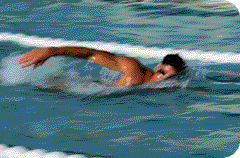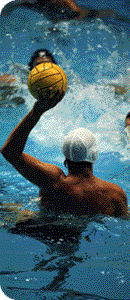Spotlight on Water-based
Activities
Swimming is an important
lifetime skill. Not only will you be having fun being active you could
be learning to save your life, and maybe someone else's too.
Choose a water-related activity from the alternative environment list. This can be swimming in or out of a lesson situation, like snorkeling, diving or canoeing. When you swim get someone to observe you, and never swim alone.

Self-challenge Activities
Decide with your
teacher which of these activities to complete:
- Can you float on your back or front?
- Can you perform a handstand in the water? Is it easier in or out of the water?
- Using flutter boards to support your arms, try moving through the water by kicking for as long as you can. Record your time. In your next session, try to improve your performance by 10%.
|
 |
![]()
 |
 |
Putting
the Tech into Technique
The best way to learn how to swim is to take lessons from a qualified
instructor. But even if you practice at a local lake -with a qualified
swim buddy - try to remember to practice the following points.
When you're moving through the water, get someone to observe you for the following actions:
- Are your leg movements initiated from the thighs?
- Are legs relatively straight?
- Make sure that your heels just break the surface of the water.
- Do you have a strong downward push against the water?
![]()
activities | health benefits | cooperation | do it daily for life
